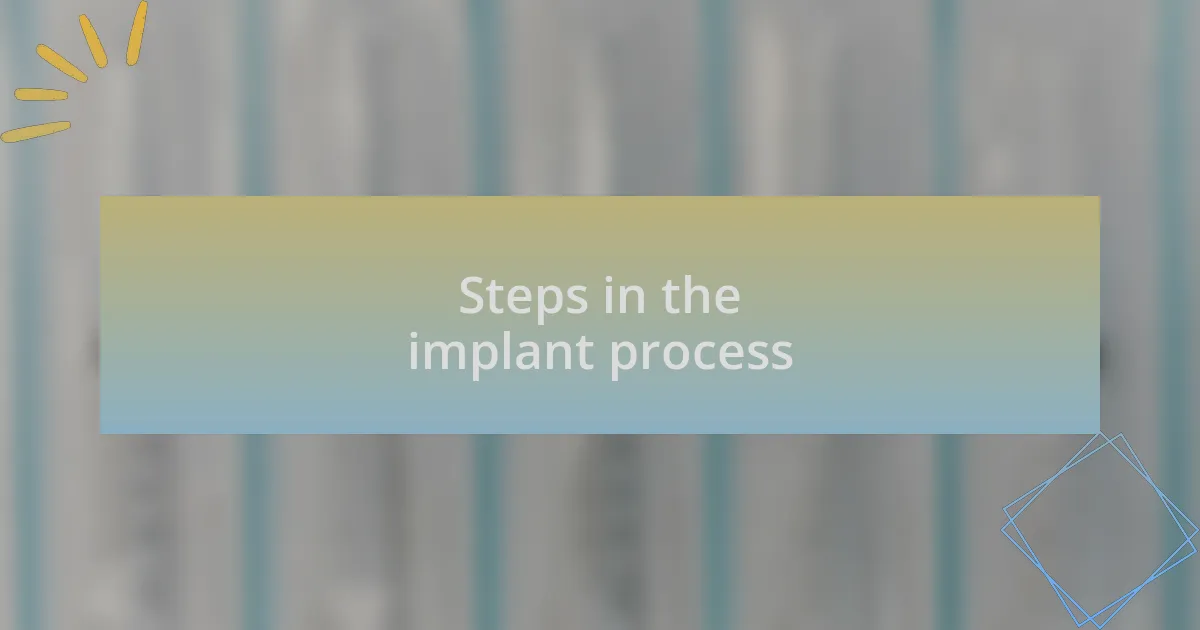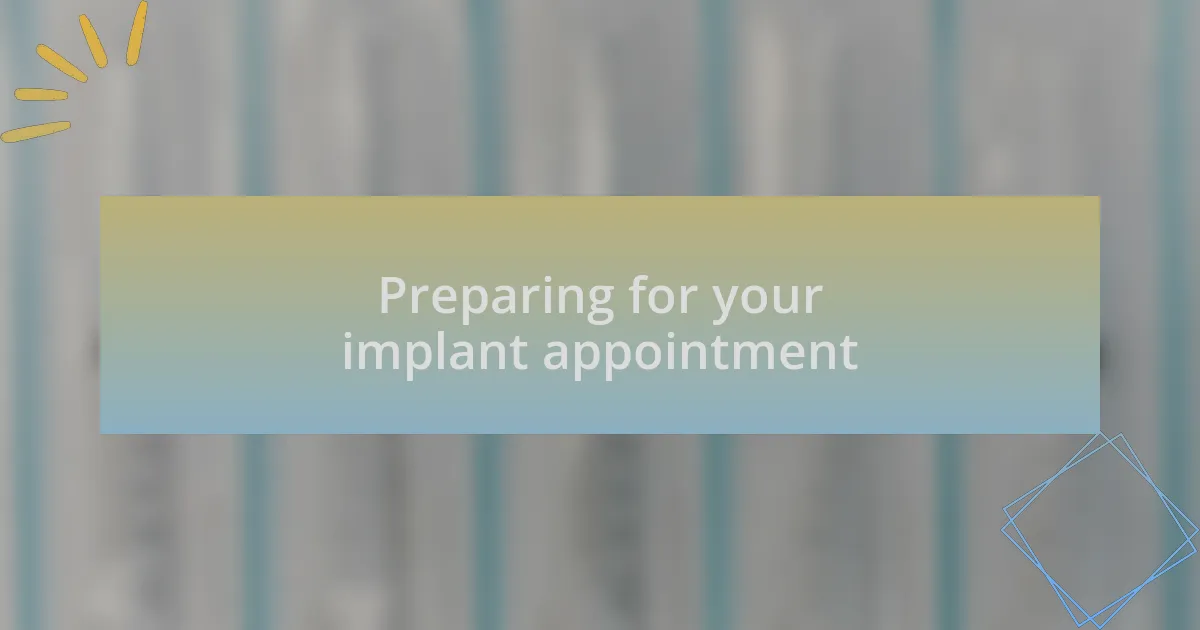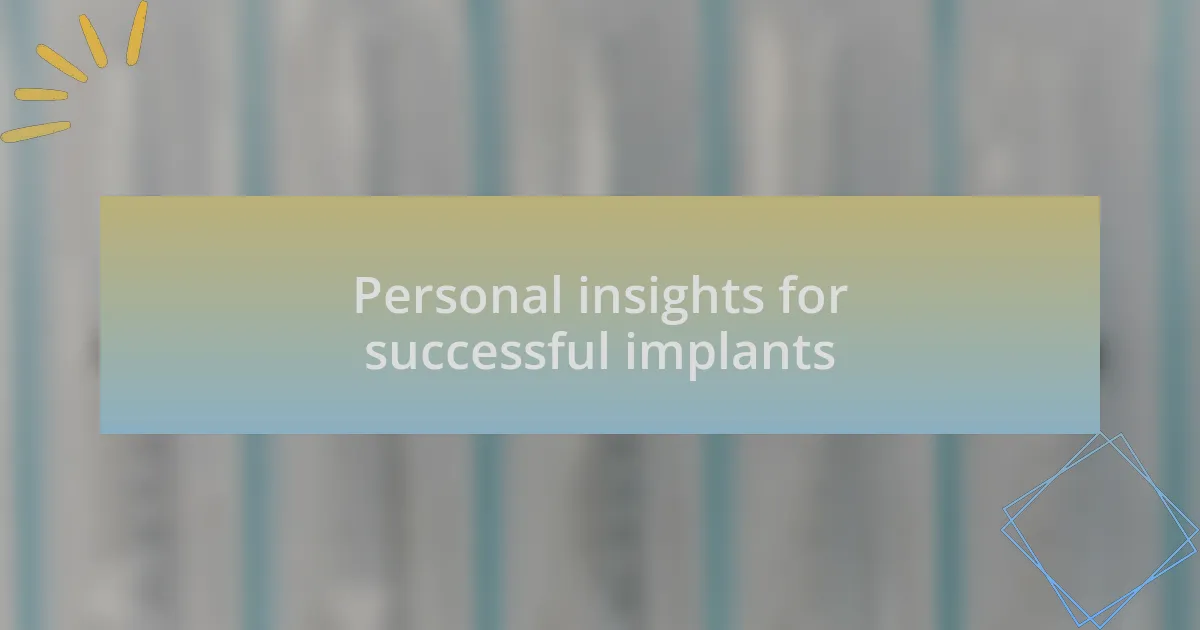Key takeaways:
- Dental implants consist of a titanium post and porcelain tooth, offering long-lasting solutions for missing teeth.
- The implant process includes a consultation, surgical placement, and a healing period for osseointegration, requiring patience from patients.
- Preparing for the appointment involves transparency about medical history, managing expectations, and planning for post-operative care.
- Effective communication with the dental team and maintaining a positive mindset are crucial for a successful implant experience and recovery.

Understanding dental implants
Dental implants are a remarkable solution for replacing missing teeth, offering both functionality and aesthetic appeal. From my experience working with patients, I’ve seen their faces light up upon realizing that implants can restore not just their smiles but also their confidence. Isn’t it fascinating how something so small can make such a significant difference in someone’s life?
The implant itself consists of a titanium post that acts as a root for the artificial tooth, which is usually made of porcelain. When I first learned about the interaction between the implant and jawbone, I couldn’t help but marvel at how the body integrates with this foreign object. Have you ever thought about how resilient our bodies can be in adapting to new materials?
One of the most rewarding aspects of dental implants is their longevity. I often hear patients wondering, “How long will this last?” Well, with proper care, implants can last for decades. It’s comforting to know that commitment to good oral hygiene can lead to years of health and happiness. Wouldn’t you agree that investing in a dental implant is investing in a future full of smiles?

Steps in the implant process
The first step in the implant process typically involves a comprehensive consultation. I remember a patient who was understandably anxious about the whole procedure, but once we discussed their specific needs and expectations, that tension transformed into optimism. Have you ever noticed how understanding the process can alleviate fears?
Next, we move on to the surgical phase, where the titanium post is placed into the jawbone. This part of the process often surprises patients; they think it will be painful, but I assure them that anesthesia makes it quite manageable. Isn’t it intriguing how our minds can play tricks on us, filling us with anxiety over what often turns out to be a straightforward procedure?
After the post is secured, there’s a healing period where osseointegration happens. I find this phase fascinating because it’s like watching a miraculous biological dance—our body embracing the new implant as part of itself. Patients frequently ask me, “How long will this healing take?” And I tell them, patience is key; it usually takes a few months, but the reward is worth it in the end. Have you ever felt like the wait for something great made the outcome even sweeter?

Preparing for your implant appointment
Preparing for your implant appointment begins with a thorough discussion about your medical history. I often emphasize the importance of transparency during this conversation. One time, a patient withheld some previous health issues which later turned out to be relevant. Have you ever felt uneasy about sharing personal information? Remember, this is about your health, and the more information we share, the better we can tailor the treatment to your needs.
Another crucial step is to have realistic expectations about the process and its timeline. I frequently remind my patients that patience is essential in dental implants. I recall working with a patient who expected immediate results, and when we discussed the healing process, it really helped in managing her anxiety. Isn’t it comforting to understand that good things often take time?
Lastly, I encourage patients to prepare for some post-operative care. This might feel daunting, but I reassure them it’s manageable. When I had my dental procedure, I took the time to stock up on soft foods and pain relievers, and it made my recovery much smoother. Have you considered how planning ahead can transform your experience?

Tips for a smooth recovery
It’s important to follow your dentist’s post-operative instructions closely for a smooth recovery. I remember a patient who didn’t ice her cheek as recommended, and she ended up swelling more than necessary. It’s such a simple step that can significantly impact your comfort—have you ever noticed how small actions can have big results?
Hydration plays a vital role during the recovery process. After my own dental surgery, I made a conscious effort to drink plenty of water, which helped reduce my discomfort. I found that staying hydrated not only kept my energy up but also improved my healing. Wouldn’t it be great if we all paid a bit more attention to our water intake during recovery?
Additionally, don’t underestimate the power of rest. In my experience, pushing too hard can lead to slower healing. I once over-exerted myself too soon after an implant and regretted it later when the discomfort returned. Remember, giving yourself the time and space to heal properly is a form of self-care—don’t you think we all deserve that?

Communicating with your dental team
Effective communication with your dental team is crucial throughout the entire implant process. I recall my first visit when I felt overwhelmed with questions. I learned that openly discussing my concerns and expectations not only eased my anxiety but also helped the team tailor their approach to my needs. Have you ever left a meeting feeling uncertain because you didn’t ask enough questions?
Don’t hesitate to speak up about any discomfort or confusion; your dental team is there to help you. After my procedure, I felt a bit unusual and reached out to verify if it was normal. The reassurance I received not only calmed my nerves but also reinforced the bond of trust between us. Isn’t it comforting to know that your dental team genuinely cares about your well-being?
Lastly, maintaining an ongoing dialogue with your dentist can enhance the outcome of your implant journey. I had a follow-up appointment where we reviewed my progress, and it was gratifying to discuss my healing process together. Engaging actively with your team fosters a collaborative environment, making the entire experience smoother—don’t you agree that a strong partnership can make all the difference?

Personal insights for successful implants
One of my key insights for a successful implant process is the importance of preparation. I remember spending time researching what to expect before my own procedure. Gaining that knowledge not only made me feel more confident but also empowered me to ask informed questions during my consultations. Have you ever found that being prepared made a nerve-wracking experience feel more manageable?
Additionally, understanding the aftercare is vital. I vividly recall my dentist emphasizing the significance of following post-operative instructions. At first, I was tempted to skip some steps, thinking they were unnecessary. However, I quickly realized that adhering to those guidelines was crucial for healing. Isn’t it remarkable how following simple instructions can lead to such a smoother recovery?
Lastly, maintaining a positive mindset can profoundly impact your experience. During my journey, I made a conscious effort to visualize successful outcomes. This mental shift helped me handle any discomfort during the healing process more resiliently. Have you ever noticed how your attitude can influence your perception of an experience?